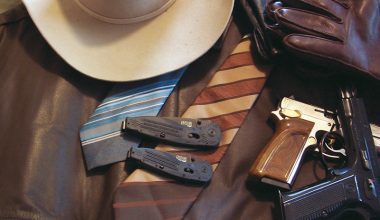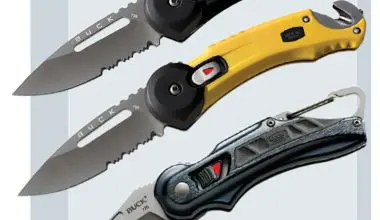IN 1998, a new American knife company burst onto the scene with black-coated heavy-duty knives with saw backs. I had to have one.
The company was TOPS Knives from Idaho Falls and, 18 years later, they’re still going strong. In recent years, TOPS has been retaining the expertise of professionals in various fields to put their experience and vision to work designing knives for TOPS.
The roster of designers includes firefighters, martial artists, military, search-and-rescue personnel, hunters, law enforcement, survival practitioners, trackers, and a variety of professional outdoorsmen.
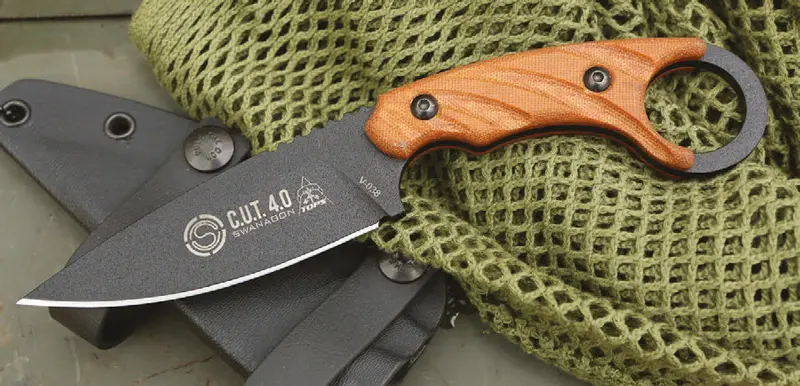
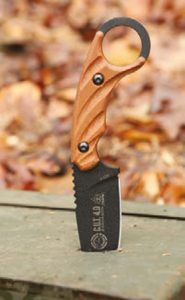
THE DESIGN
The newest offering from TOPS Knives comes from S.W.A.T. Magazine contributor Joshua Swanagon, who is also no stranger to TOPS. A few years ago, he designed for TOPS the Backwoods Skinner, which was influenced by the Alaskan Ulu knife. His latest design is the C.U.T. 4.0, considered a dual-purpose knife suitable for self-defense and urban survival. C.U.T. is an acronym for Combat Utility Tool.
The C.U.T. 4.0 has a total length of 8½ inches, with a 41/8-inch long blade, full tang, and 3/16-inch thick stock. The actual cutting edge is right at four inches long, hence the 4.0 name. Joshua went with a sabre grind, which gives the knife some nice lines, and a V cutting grind for the actual edge.
The knife features black tractioncoated 1095 carbon steel with a Rockwell hardness between 56 and 58. The scales (handles) are tan Micarta with a unique pattern. I’ve heard Joshua call it a sunburst pattern, but it’s officially called a dragonfly pattern.
The curved handle and ring of a karambit design are used on the C.U.T. 4.0 to provide superior comfort during combative use. These elements were taken from Joshua’s extensive martialarts background. Known as kerambit in its native Indonesia, it is called the karambit in the Philippines and most Western countries.
The karambit-style knife is held with the blade pointing downward from the bottom of the fist, usually curving forward but occasionally backward. While it is primarily used in a slashing or hooking motion, the karambit’s finger ring is also used in a punching motion to hit the opponent with it. The C.U.T. 4.0 is very useful in self-defense situations due to this flexibility of striking methods.
The finger guard makes it difficult to disarm and allows the knife to be maneuvered in the fingers without losing one’s grip. The ring is large enough to accommodate a thick work glove or cold-weather gloves. The oversized ring also makes a good hammering surface, both to hammer with and to strike this area with a mallet or chunk of wood to hammer the blade into something.
The sheath features Pull-The-Dot one-way directional snaps. From the factory, the Kydex® sheath is set up for scout carry (horizontally), where it can be deployed in a reverse grip or crossdraw position. However, the sheath system allows for many different styles of carry. Total weight is 9 ounces with sheath and 6.3 ounces for the knife only.
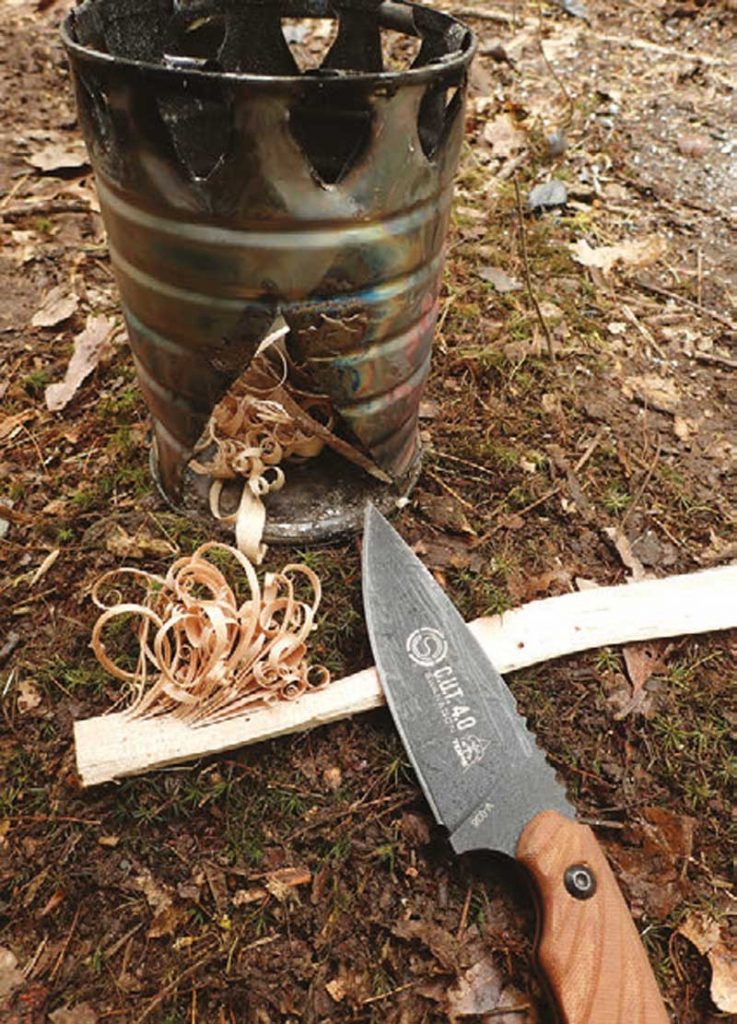
COMBAT & URBAN SURVIVAL TESTING
One feature that really stood out to me was the knife’s sharp point. It screams “penetration.” Toward the tip is a nice taper that aids in penetration as the 3/16-inch thick steel gradually gets thinner, resulting in a sharp point. It was designed to pierce through heavy clothing and body armor.
I took a metal ammo can and stabbed through it with the C.U.T. 4.0 as hard as I could, then used a piece of wood to baton the back of the knife on the ring to really drive it in.
The next test was more in the realm of urban survival, as I got a metal coffee can and made a woodburning hobostove out of it. I proceeded to cut a triangular section out of it using the C.U.T. 4.0. This was harsh and grueling, more on me than the knife. I had to use many different grips just to get through and cut the correct angles. All were pretty secure in my hand due to the dragonfly handle pattern and the more aggressive than usual jimping, which I normally don’t care for on a knife.
After quite the undertaking, I wanted to see how the edge would fare on a few more urban survival tasks, like making kindling for the hobo-stove and carving a simple point on a hardwood stick—especially after the amount of abuse the edge had already taken.
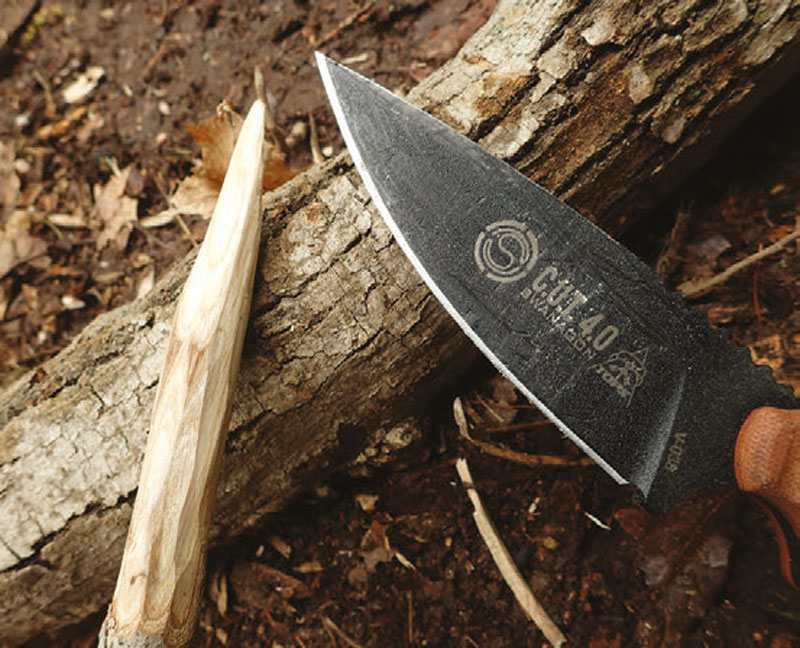
As I figured, the initial sharpness of the edge was gone, mainly due to the metal I had pounded the blade through, but the edge geometry made the work possible. I made a few fuzz sticks out of dry maple because the woods were saturated from heavy rain. The knife performed this task adequately, as well as putting a point on a piece of maple.
I left the knife out for a few days in a nearby camp I’d built, and the black coating did a great job protecting the blade from the elements.
At the end of the testing phase, the knife had lost a very small amount of the tip from the metal ammo can, and the edge had a few places where it had rolled and suffered some micro-chipping, as could be expected from this type of abuse.
But this is what it is designed to do, and the medium Rockwell hardness helps when it comes to touching up these minor wounds. After light sharpening with a Smith’s fine diamond steel, you’d be hard pressed to find any traces of it being pounded or cutting through metal, except for the scratches and wear marks on the coating, which I personally like. They say, “I was used … hard!” This is a hard-use tool and it acted accordingly.
The TOPS C.U.T. 4.0 is a good choice for martial arts enthusiasts, law enforcement, military, outdoorsmen, and practitioners of survival or escape & evasion.
Joshua put a lot of time and detail into his design, and TOPS Knives did a great job executing it!

